—————————————————————————————
“玩转”Java 系列
题目:企业 SQL 面试复习与测试
一、 SQL 复习
1.常见的数据库对象有哪些?
表(table) 视图(view) 序列(sequence) 索引(index) 同义词(synonym)
存储过程(procedure) 存储函数(function) 触发器(trigger)
2.表:数据的主要存储方式,由行和列组成。后面重点说
视图:存储起来的 select 语句。
对视图中数据的 DML 操作,会导致创建视图使用的表中的数据的修改。
create view emp_vu
as
select department_id,avg(salary) dept_avg_sal
from employees
group by department_id;
--with read only
select * from emp_vu;
序列:提供了一系列有规律的数值,常用来作为表的主键的值
create sequence emp_id_seq
start with 1001
increment by 1
maxvalue 10000
--minvalue
--cycle/nocycle
--cache/nocache
1)nextval / currval
select emp_id_seq.currval from dual;
select emp_id_seq.nextval from dual;
create table emp(
id number(10),
name varchar2(15)
)
insert into emp
values(emp_id_seq.nextval,'BB');
1
�
“玩转”Java 系列
—————————————————————————————
select * from emp;
裂缝:①多个表共用一个序列②出现回滚③出现异常
索引(index):当使用索引作用的列作为查询条件进行查询时,可以提高查询的效
率。
--如何创建索引:①自动创建(声明为主键或唯一性约束的列) ②手动创
建
create index emp_sal
on employees(salary);
3.重点:表
DDL:CREATE TABLE;ALTER TABLE;TRUNCATE TABLE;DROP TABLE;RENAME .. TO ..
不可回滚,即意味着:自动提交
--1.创建表
--1.1“白手起家”
create table dept(
dept_id number(10),
dept_name varchar2(15),
location_id varchar2(10),
birth Date
)
select * from dept;
--1.2 基于现有的表,创建
create table emp1
as
select employee_id id,last_name name,hire_date,salary
from employees
--where department_id = 80;
where 1=2;
select * from emp1;
--1)对现有的表的复制/空表
create table emp_copy
as
select * from employees
--where 1=2;
select * from emp_copy;
2
�
“玩转”Java 系列
—————————————————————————————
--2.修改表
--2.1 增加一个列
ALTER table emp
add(salary number(10,2) default 2000);
select * from emp;
--2.2 修改现有的列
alter table emp
modify(salary number(15,2));
insert into emp(id,name)
values(1004,'CC');
--2.3 重命名现有的列
alter table emp
rename column salary to sal;
--2.4 删除现有的列
alter table emp
drop column sal;
--3.重命名现有的表
rename emp to employee;
select * from employee;
--4.清空表
truncate table employee;
rollback;
--5.删除表
drop table employee;
DML:增、删、改、查
--增 insert into ...
--1.一条一条的添加
select * from dept;
insert into dept
3
�
“玩转”Java 系列
—————————————————————————————
values(,,,);
insert into dept(dept_id,location_id,dept_name)
values(,,);
--2.导入数据
insert into dept(dept_id,location_id,dept_name)
select department_id,location_id,department_name
from departments;
alter table dept
modify(dept_name varchar2(20));
--删
delete from dept
where dept_id < 40;
--改
update dept
set location_id = 1700
where dept_id = 20;
commit;
--查询(重中之重)
select .... --分组函数(count / max / min / avg / sum)
from ...,....--多表连接
where ...--过滤条件和 多表的连接条件(若不写,会出现笛卡尔积的错误)
group by ...--凡是在 select 中出新了分组函数,则没有使用分组函数的列要作为
group by 的条件
having avg(..) ...--分组函数作为过滤条件,要使用 having
order by ... asc/desc;
二、企业 SQL 考核真题
数据表:
dept:
deptno(primary key), dname, loc
emp:
empno(primary key), ename, job, mgr(references emp(empno)), sal,
deptno(references dept(deptno))
4
�
“玩转”Java 系列
—————————————————————————————
EMP
empno(primary key)
ename
job
mgr(references emp(empno))
sal
deptno(references dept(deptno))
DEPT
deptno(primary key)
dname
loc
1 列出 emp 表中各部门的部门号,最高工资,最低工资
select max(sal) as 最高工资,min(sal) as 最低工资,deptno from emp group by
deptno;
2 列出 emp 表中各部门 job 含’REP’的员工的部门号,最低工资,最高工资
select max(sal) as 最高工资,min(sal) as 最低工资,deptno as 部门号 from emp
where job like '%REP%' group by deptno;
3 对于 emp 中最低工资小于 7000 的部门中 job 为'SA_REP'的员工的部门号,最
低工资,最高工资
select max(sal) as 最高工资,min(sal) as 最低工资,deptno as 部门号 from emp b
where job='SA_REP' and 7000>(select min(sal) from emp a where
a.deptno=b.deptno) group by b.deptno
4 写出对上题的另一解决方法
(请补充)
select deptno,min(sal),max(sal)
from emp
where job = 'SA_REP' and deptno in (
select deptno
from emp
--group by deptno
having min(sal) < 7000
)
group by deptno
5 根据部门号由高而低,工资由低而高列出每个员工的姓名,部门号,工资
select deptno as 部门号,ename as 姓名,sal as 工资 from emp order by deptno
desc,sal asc
6 列出'Abel'所在部门中每个员工的姓名与部门号
select ename,deptno from emp where deptno = (select deptno from emp where
ename = 'Abel')
5
�
—————————————————————————————
“玩转”Java 系列
(法二)
select ename,deptno
from emp e1
where exists (
select 'x'
from emp e2
where e1.deptno = e2.deptno
and e2.ename = 'Abel'
)
7 列出每个员工的姓名,工作,部门号,部门名
select ename,job,emp.deptno,dept.dname from emp,dept where
emp.deptno=dept.deptno
8 列出 emp 中工作为'SH_CLERK'的员工的姓名,工作,部门号,部门名
select ename,job,dept.deptno,dname from emp,dept where
dept.deptno=emp.deptno and job='SH_CLERK'
9 对于 emp 中有管理者的员工,列出姓名,管理者姓名(管理者外键为 mgr)
select a.ename as 姓名,b.ename as 管理者 from emp a,emp b where a.mgr is
not null and a.mgr=b.empno
10 对于 dept 表中,列出所有部门名,部门号,同时列出各部门工作为'SH_CLERK'
的员工名与工作
select dname as 部门名,dept.deptno as 部门号,ename as 员工名,job as 工作
from dept,emp
where dept.deptno = emp.deptno(+) and job = 'SH_CLERK'
11 对于工资高于本部门平均水平的员工,列出部门号,姓名,工资,按部门号
排序
select a.deptno as 部门号,a.ename as 姓名,a.sal as 工资 from emp a
where a.sal>(select avg(sal) from emp b where a.deptno=b.deptno) order by
a.deptno
(法二)select e.deptno,ename,sal
from emp e,(select deptno,avg(sal) avg_sal from emp group by deptno)
b
where e.sal > b.avg_sal and e.deptno = b.deptno
6
�
“玩转”Java 系列
—————————————————————————————
12 对于 emp,列出各个部门中工资高于本部门平均水平的员工数和部门号,按
部门号排序
select count(a.sal) as 员工数,a.deptno 部门号 from emp a
where a.sal>(select avg(sal) from emp b where a.deptno=b.deptno) group by
a.deptno order by a.deptno
13. 对于 emp 中工资高于本部门平均水平,人数多于 1 人的,列出部门号,高于
部门平均工资的人数,按部门号排序
select *
from(
select deptno,count(*) count_num
from emp e
where sal > (
select avg(sal)
from emp e1
where e.deptno = e1.deptno
)
group by deptno
) e1
where e1.count_num > 1
order by e1.deptno
14 对于 emp 中工资高于本部门平均水平,且其人数多于 3 人的,列出部门号,
部门人数,按部门号排序
select count(a.empno) as 员工数,a.deptno as 部门号,avg(sal) as 平均工资 from
emp a
where (select count(c.empno) from emp c where c.deptno=a.deptno and
c.sal>(select avg(sal) from emp b where c.deptno=b.deptno))>3
group by a.deptno order by a.deptno
(法二)
select m.deptno,count(ee1.empno)
from(
select e1.deptno,count(empno) count_num
from emp e1
where e1.sal >
(select avg(sal) from emp e2 where e1.deptno = e2.deptno)
group by e1.deptno
) m,emp ee1
7
�
—————————————————————————————
where m.count_num > 3 and m.deptno = ee1.deptno
“玩转”Java 系列
group by m.deptno
15 对于 emp 中低于自己工资至少 5 人的员工,列出其部门号,姓名,工资,以
及工资少于自己的人数
select a.deptno,a.ename,a.sal,(select count(b.ename) from emp as b where
b.sal
5
8
�
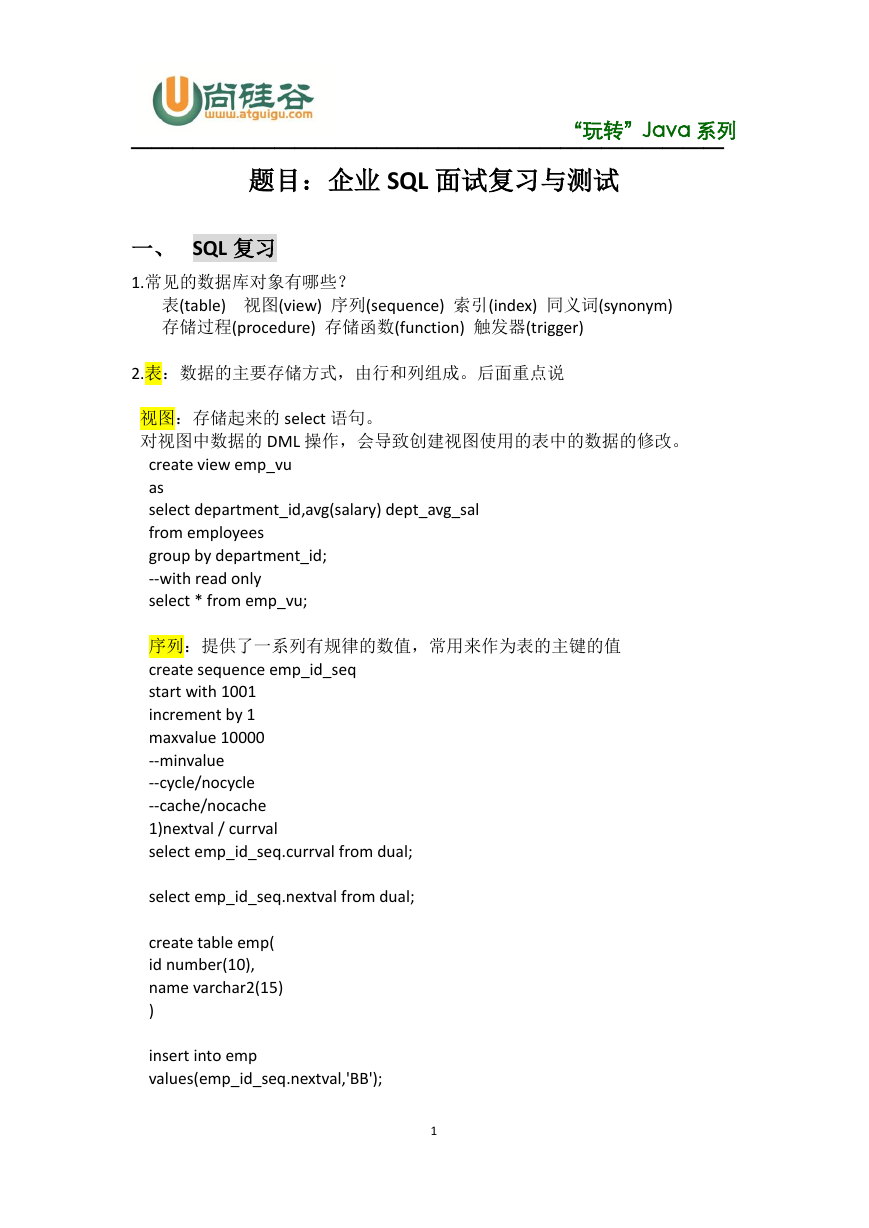
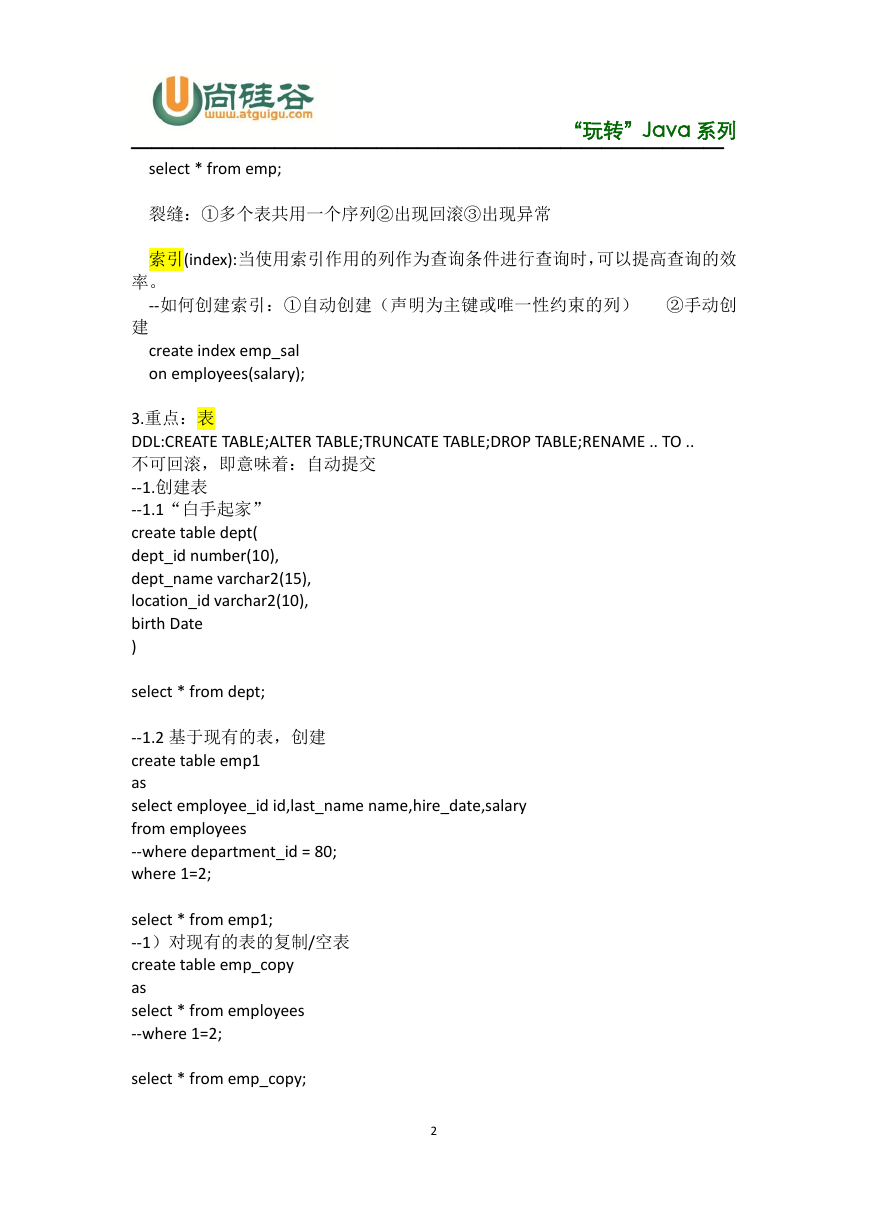
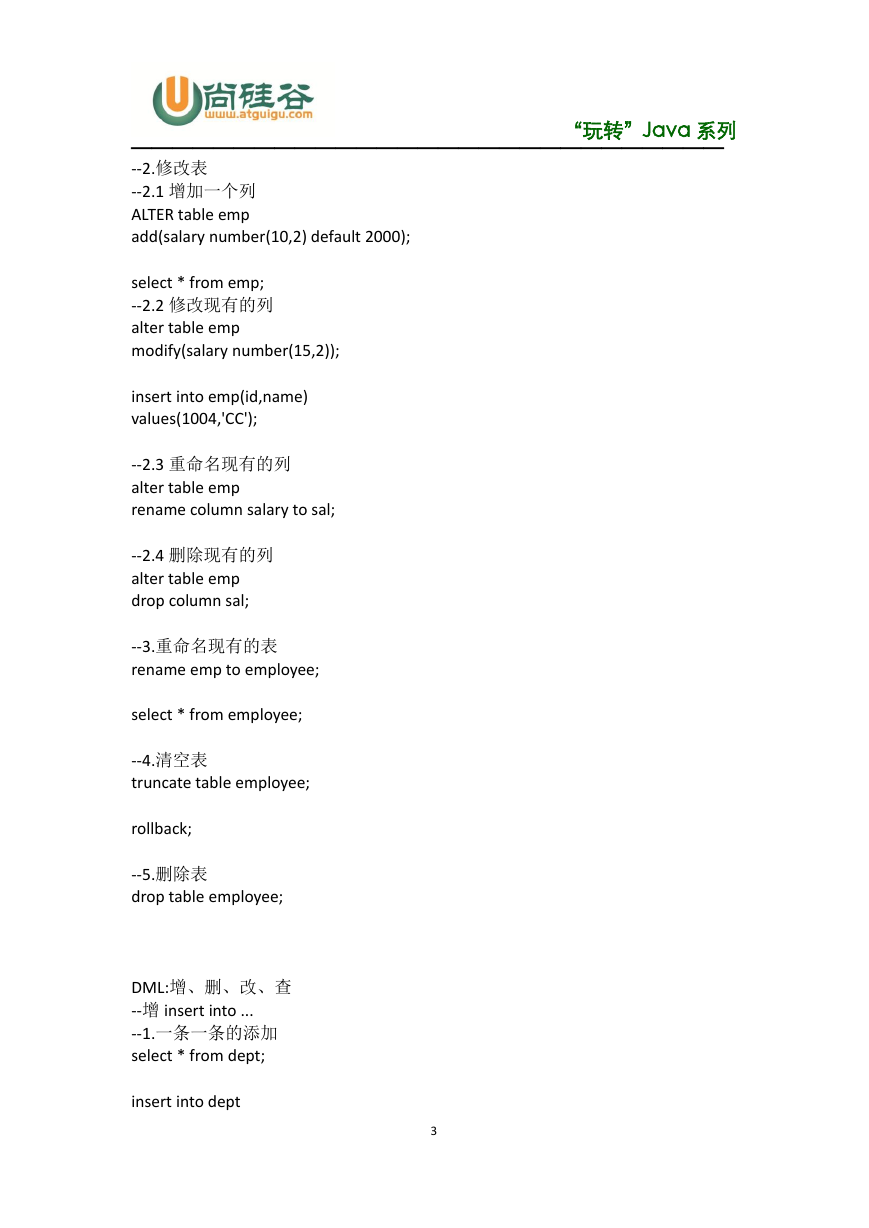
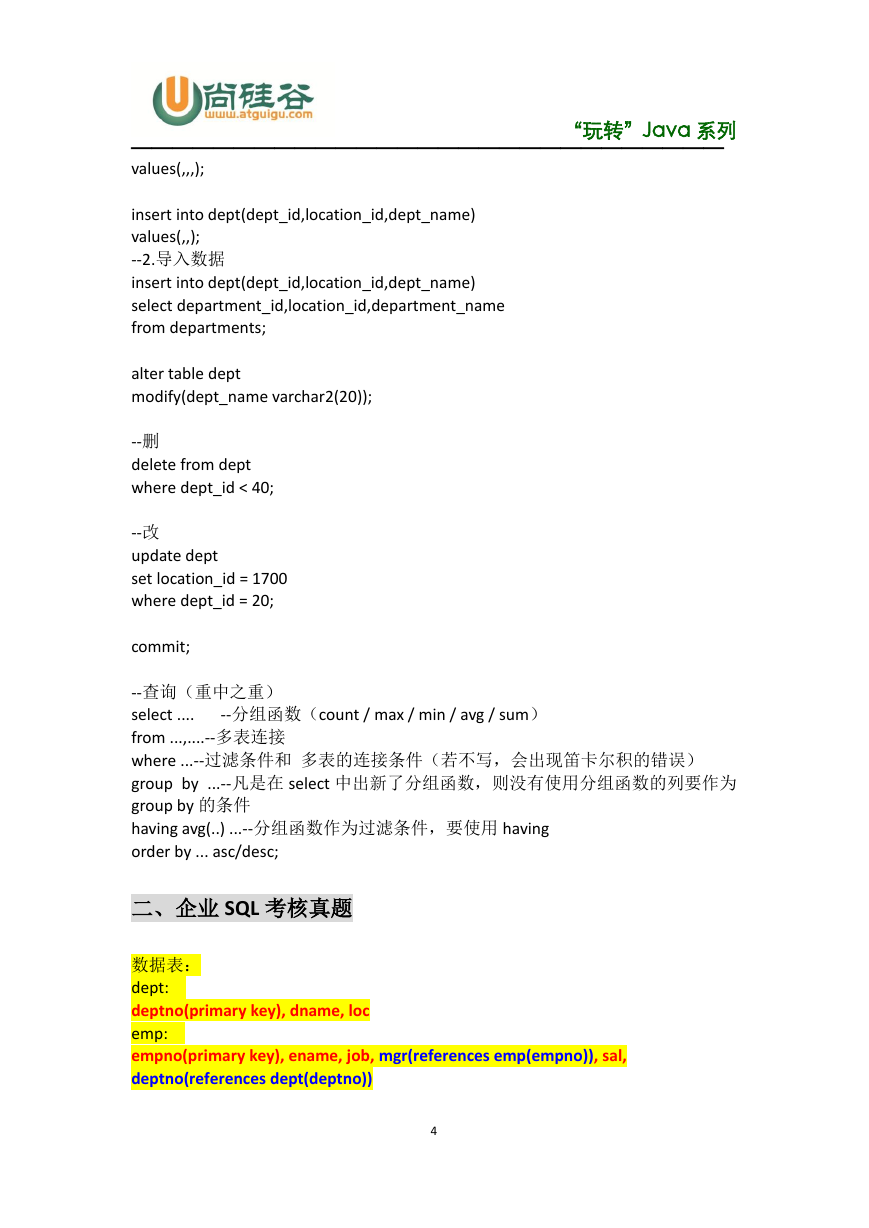
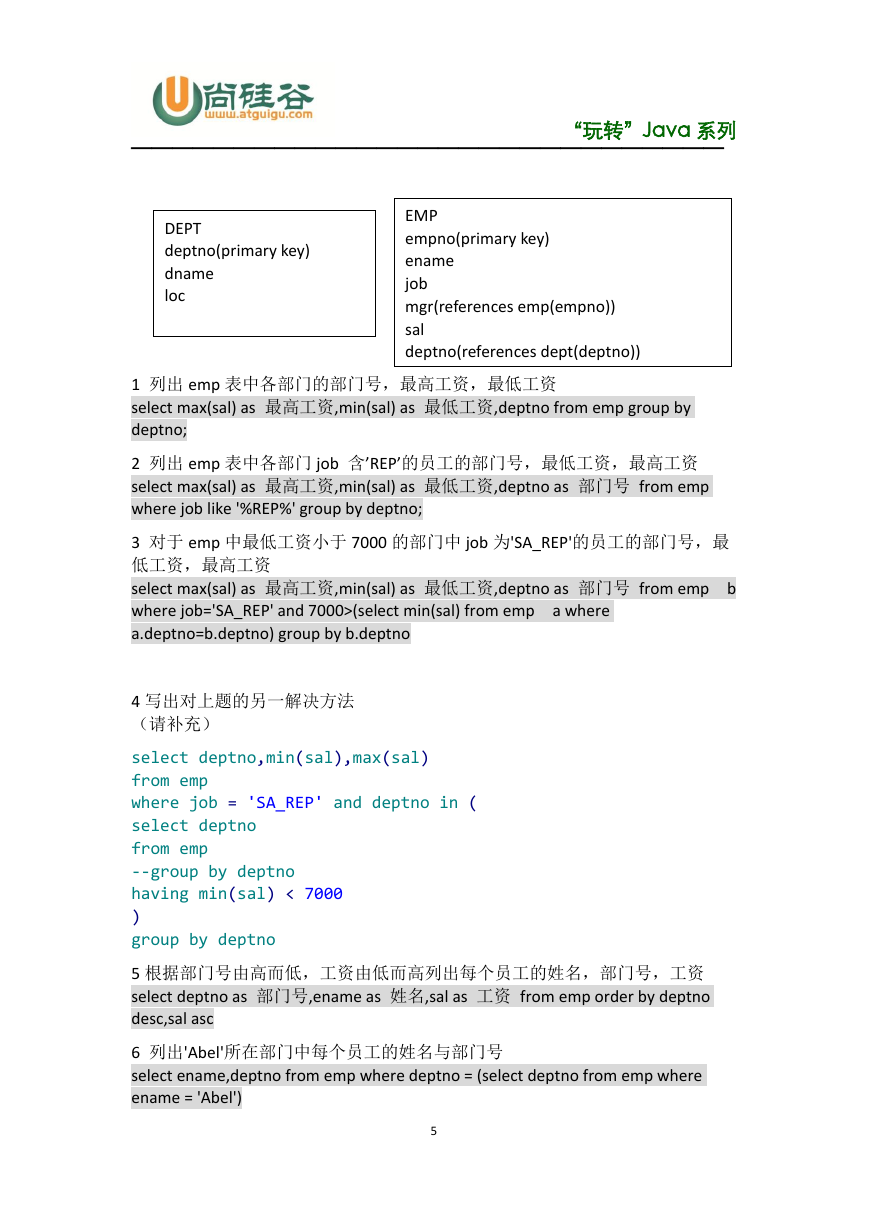
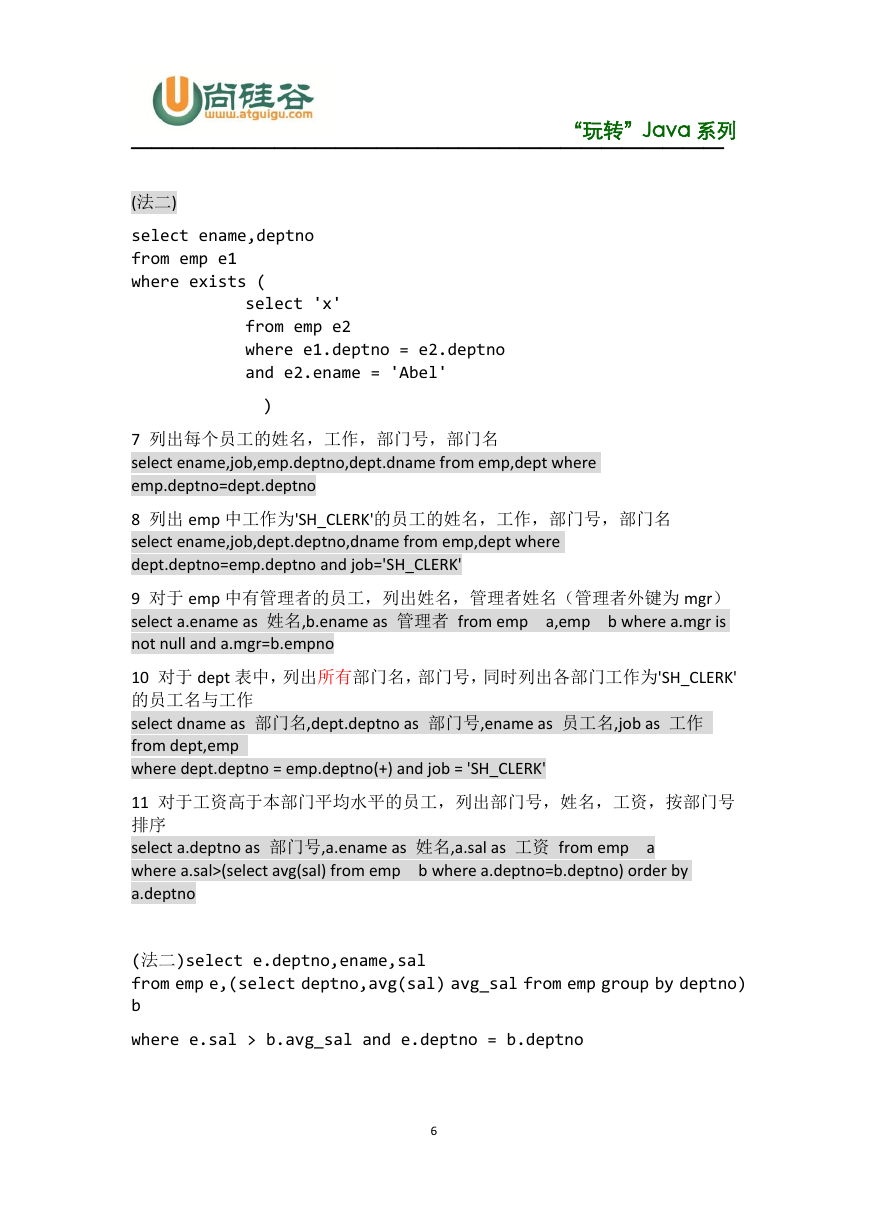
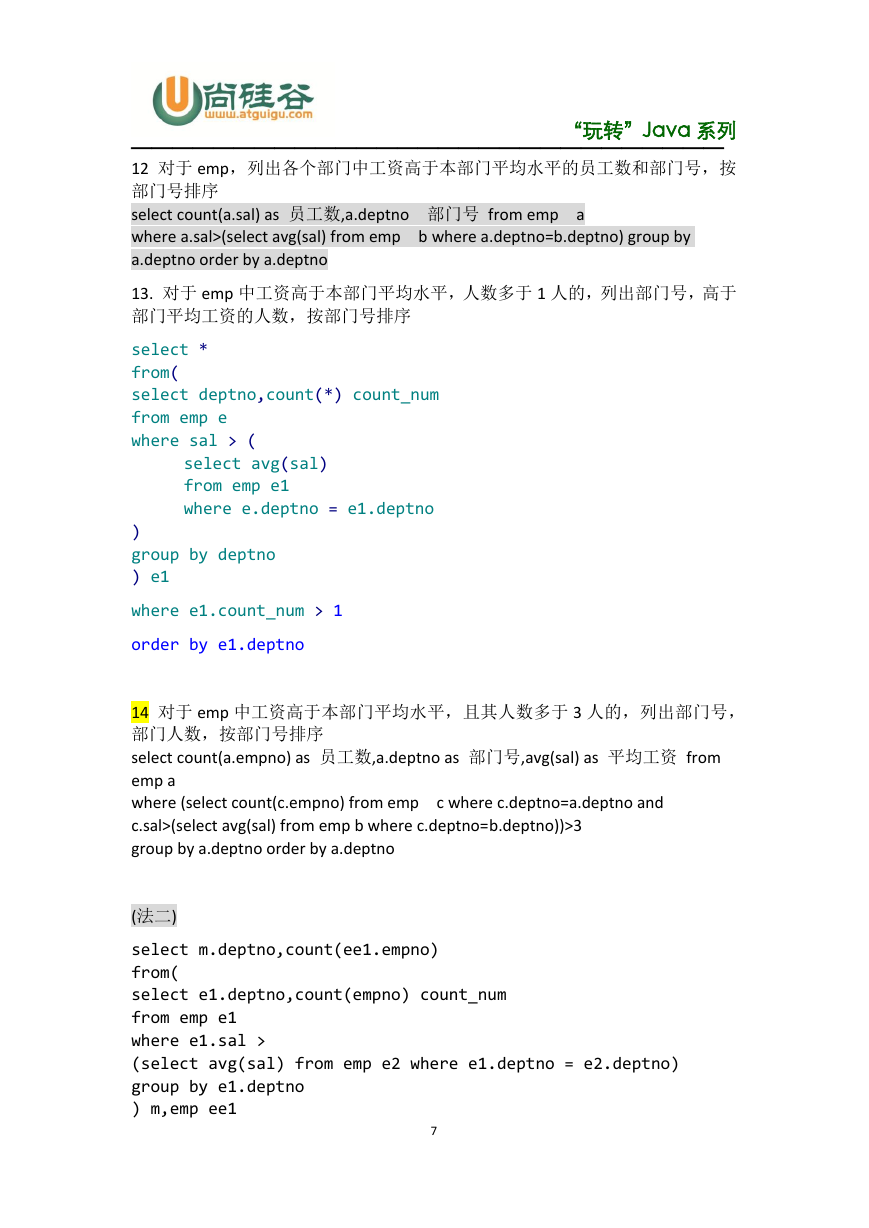









 2023年江西萍乡中考道德与法治真题及答案.doc
2023年江西萍乡中考道德与法治真题及答案.doc 2012年重庆南川中考生物真题及答案.doc
2012年重庆南川中考生物真题及答案.doc 2013年江西师范大学地理学综合及文艺理论基础考研真题.doc
2013年江西师范大学地理学综合及文艺理论基础考研真题.doc 2020年四川甘孜小升初语文真题及答案I卷.doc
2020年四川甘孜小升初语文真题及答案I卷.doc 2020年注册岩土工程师专业基础考试真题及答案.doc
2020年注册岩土工程师专业基础考试真题及答案.doc 2023-2024学年福建省厦门市九年级上学期数学月考试题及答案.doc
2023-2024学年福建省厦门市九年级上学期数学月考试题及答案.doc 2021-2022学年辽宁省沈阳市大东区九年级上学期语文期末试题及答案.doc
2021-2022学年辽宁省沈阳市大东区九年级上学期语文期末试题及答案.doc 2022-2023学年北京东城区初三第一学期物理期末试卷及答案.doc
2022-2023学年北京东城区初三第一学期物理期末试卷及答案.doc 2018上半年江西教师资格初中地理学科知识与教学能力真题及答案.doc
2018上半年江西教师资格初中地理学科知识与教学能力真题及答案.doc 2012年河北国家公务员申论考试真题及答案-省级.doc
2012年河北国家公务员申论考试真题及答案-省级.doc 2020-2021学年江苏省扬州市江都区邵樊片九年级上学期数学第一次质量检测试题及答案.doc
2020-2021学年江苏省扬州市江都区邵樊片九年级上学期数学第一次质量检测试题及答案.doc 2022下半年黑龙江教师资格证中学综合素质真题及答案.doc
2022下半年黑龙江教师资格证中学综合素质真题及答案.doc